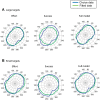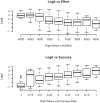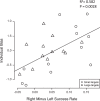Effort, success, and nonuse determine arm choice
- PMID: 25948869
- PMCID: PMC4509397
- DOI: 10.1152/jn.00593.2014
Effort, success, and nonuse determine arm choice
Abstract
How do humans choose one arm or the other to reach single targets in front of the body? Current theories of reward-driven decisionmaking predict that choice results from a comparison of "action values," which are the expected rewards for possible actions in a given state. In addition, current theories of motor control predict that in planning arm movements, humans minimize an expected motor cost that balances motor effort and endpoint accuracy. Here, we test the hypotheses that arm choice is determined by comparison of action values comprising expected effort and expected task success for each arm, as well as a handedness bias. Right-handed subjects, in either a large or small target condition, were first instructed to use each hand in turn to shoot through an array of targets and then to choose either hand to shoot through the same targets. Effort was estimated via inverse kinematics and dynamics. A mixed-effects logistic-regression analysis showed that, as predicted, both expected effort and expected success predicted choice, as did arm use in the preceding trial. Finally, individual parameter estimation showed that the handedness bias correlated with mean difference between right- and left-arm success, leading to overall lower use of the left arm. We discuss our results in light of arm nonuse in individuals' poststroke.
Keywords: decisionmaking; motor control; motor cost; motor effort; reaching.
Copyright © 2015 the American Physiological Society.
Figures





Similar articles
-
Effort, success, and side of lesion determine arm choice in individuals with chronic stroke.J Neurophysiol. 2022 Jan 1;127(1):255-266. doi: 10.1152/jn.00532.2020. Epub 2021 Dec 8. J Neurophysiol. 2022. PMID: 34879206 Free PMC article.
-
Hemispheric differences in the control of limb dynamics: a link between arm performance asymmetries and arm selection patterns.J Neurophysiol. 2013 Feb;109(3):825-38. doi: 10.1152/jn.00885.2012. Epub 2012 Nov 14. J Neurophysiol. 2013. PMID: 23155169 Free PMC article.
-
Reach endpoint formation during the visuomotor planning of free arm pointing.Eur J Neurosci. 2014 Nov;40(10):3491-503. doi: 10.1111/ejn.12721. Epub 2014 Sep 11. Eur J Neurosci. 2014. PMID: 25209101
-
Evidence for right-hand feeding biases in a left-handed population.Laterality. 2015 May;20(3):287-305. doi: 10.1080/1357650X.2014.961472. Epub 2014 Sep 26. Laterality. 2015. PMID: 25256315
-
What determines choice of limb for unimanual reaching movements?J Gen Psychol. 2000 Apr;127(2):178-84. doi: 10.1080/00221300009598577. J Gen Psychol. 2000. PMID: 10843260 Review.
Cited by
-
Hand choice is unaffected by high frequency continuous theta burst transcranial magnetic stimulation to the posterior parietal cortex.PLoS One. 2022 Oct 13;17(10):e0275262. doi: 10.1371/journal.pone.0275262. eCollection 2022. PLoS One. 2022. PMID: 36227882 Free PMC article.
-
Accounting for the valley of recovery during post-stroke rehabilitation training via a model-based analysis of macaque manual dexterity.Front Rehabil Sci. 2022 Dec 20;3:1042912. doi: 10.3389/fresc.2022.1042912. eCollection 2022. Front Rehabil Sci. 2022. PMID: 36644290 Free PMC article.
-
Effects of arm weight and target height on hand selection: A low-cost virtual reality paradigm.PLoS One. 2019 Jun 21;14(6):e0207326. doi: 10.1371/journal.pone.0207326. eCollection 2019. PLoS One. 2019. PMID: 31226117 Free PMC article.
-
Gravity support from a robotic exoskeleton increases spontaneous use of the nondominant upper extremity during a choice reaching task.J Neurophysiol. 2024 Dec 1;132(6):1693-1703. doi: 10.1152/jn.00261.2024. Epub 2024 Oct 30. J Neurophysiol. 2024. PMID: 39475492
-
Now and then: Hand choice is influenced by recent action history.Psychon Bull Rev. 2019 Feb;26(1):305-314. doi: 10.3758/s13423-018-1510-1. Psychon Bull Rev. 2019. PMID: 30039397 Free PMC article.
References
-
- Andrews K, Stewart J. Stroke recovery: he can but does he? Rheumatol Rehabil 18: 43–48, 1979. - PubMed
-
- Behrens TE, Woolrich MW, Walton ME, Rushworth MF. Learning the value of information in an uncertain world. Nat Neurosci 10: 1214–1221, 2007. - PubMed
-
- Bishop DV, Ross VA, Daniels MS, Bright P. The measurement of hand preference: a validation study comparing three groups of right-handers. Br J Psychol 87: 269–285, 1996. - PubMed
-
- Bryden PJ, Pryde KM, Roy EA. A performance measure of the degree of hand preference. Brain Cogn 44: 402–414, 2000. - PubMed
Publication types
MeSH terms
Grants and funding
LinkOut - more resources
Full Text Sources
Other Literature Sources

